Influence of Alkyd Composite Coatings with Polyaniline Doped with Different Organic Acids on the Corrosion of Mild Steel
Abstract
1. Introduction
2. Materials and Methods
3. Results
3.1. Characterization of the Samples
3.2. Corrosion Behavior
4. Discussion
5. Conclusions
- In this paper, we investigated the synthesis of polyaniline in the emeraldine salt form using the procedure suggested by IUPAC.
- The emeraldine salt form was deprotonated with ammonium hydroxide and reprotonated with four different organic acids.
- Using UV–visible spectroscopy, the doping degree was estimated.
- The corrosion performances of the base coating and composite coatings with 5 wt.% of polyaniline doped with organic acids on mild steel were investigated through in situ measurements of iron concentrations in the corrosive media using the ASTM 1,10-phenanthroline method and the corrosion current density was recalculated.
- It was also shown that the protective ability of the composite coatings closely followed the initial oxidation state of the polyaniline, and that polyaniline doped with sulfamic acid with a doping degree of 0.27 had the best corrosion protection ability.
- The damaged composite coatings possessed self-healing properties.
- Blister formation and delamination were suppressed in the composite coatings due to the changes in the oxygen reduction path from the four- to mainly two-electron path, and lowering the concentration of OH− ions in the pores.
Author Contributions
Funding
Data Availability Statement
Conflicts of Interest
References
- Touileb, K.; Djoudjou, R.; Hedhibi, A.C.; Ouis, A.; Benselama, A.; Ibrahim, A.; Abdo, H.S.; Samad, U.A. Comparative microstructural, mechanical and corrosion study between dissimilar ATIG and conventional TIG weldments of 316L stainless steel and mild steel. Metals 2022, 12, 635. [Google Scholar] [CrossRef]
- Ruan, X.; Yang, L.; Wang, Y.; Dong, Y.; Xu, D.; Zhang, M. Biofilm-induced corrosion inhibition of Q235 carbon steel by Tenacibaculum mesophilum D-6 and Bacillus sp. Y-6. Metals 2023, 13, 649. [Google Scholar] [CrossRef]
- Lyon, S.B.; Bingham, R.; Mills, D.J. Advances in corrosion protection by organic coatings: What we know and what we would like to know. Prog. Org. Coat. 2017, 102, 2–7. [Google Scholar] [CrossRef]
- Rangel-Olivares, F.R.; Arce-Estrada, E.M.; Cabrera-Sierra, R. Synthesis and characterization of polyaniline-based polymer nanocomposites as anti-corrosion coatings. Coatings 2021, 11, 653. [Google Scholar] [CrossRef]
- Ćirić-Marjanović, G. Recent advances in polyaniline research: Polymerization mechanisms, structural aspects, properties and applications. Synth. Met. 2013, 177, 1–47. [Google Scholar] [CrossRef]
- Ćirić-Marjanović, G. Recent advances in polyaniline composites with metals, metalloids and nonmetals. Synth. Met. 2013, 170, 31. [Google Scholar] [CrossRef]
- Gao, F.; Mu, J.; Bi, Z.; Wang, S.; Li, Z. Recent advances of polyaniline composites in anticorrosive coatings: A review. Prog. Org. Coat. 2021, 151, 106071. [Google Scholar] [CrossRef]
- Hu, C.; Li, T.; Yin, H.; Hu, L.; Tang, J.; Ren, K. Preparation and corrosion protection of three different acids doped polyaniline/epoxy resin composite coatings on carbon steel. Colloids Surf. A Physicochem. Eng. Asp. 2021, 612, 126069. [Google Scholar] [CrossRef]
- Zhang, Y.J.; Shao, Y.W.; Liu, X.L.; Shi, C.; Wang, Y.Q.; Meng, G.Z.; Zeng, X.G.; Yang, Y. A study on corrosion protection of different polyaniline coatings for mild steel. Prog. Org. Coat. 2017, 111, 240. [Google Scholar] [CrossRef]
- Liu, S.; Liu, L.; Meng, F.; Li, Y.; Wang, F. Protective performance of polyaniline-sulfosalicylic acid/epoxy coating for 5083 aluminum. Materials 2018, 11, 292. [Google Scholar] [CrossRef]
- Zhang, Y.; Shao, Y.; Zhang, T.; Meng, G.; Wang, F. The effect of epoxy coating containing emeraldine base and hydrofluoric acid doped polyaniline on the corrosion protection of AZ91D magnesium alloy. Corros. Sci. 2011, 53, 3747–3755. [Google Scholar] [CrossRef]
- Baloch, A.; Kannan, M.B. Electropolymerisation of aniline on AZ91 magnesium alloy: The effect of coating electrolyte corrosiveness. Metals 2017, 7, 533. [Google Scholar] [CrossRef]
- Ma, Y.; Fan, B.; Liu, H.; Fan, G.; Hao, H.; Yang, B. Enhanced corrosion inhibition of aniline derivatives electropolymerized coatings on copper: Preparation, characterization and mechanism modeling. Appl. Surf. Sci. 2020, 514, 146086. [Google Scholar] [CrossRef]
- Xu, H.; Zhang, Y. A review on conducting polymers and nanopolymer composite coatings for steel corrosion protection. Coatings 2019, 9, 807. [Google Scholar] [CrossRef]
- Armelin, E.; Alemán, C.; Iribarren, J.I. Anti-corrosion performances of epoxy coatings modified with polyaniline: A comparison between the emeraldine base and salt forms. Prog. Org. Coat. 2009, 65, 88. [Google Scholar] [CrossRef]
- Diniz, F.B.; De Andrade, G.F.; Martins, C.R.; De Azevedo, W.M. A comparative study of epoxy and polyurethane based coatings containing polyaniline-DBSA pigments for corrosion protection on mild steel. Prog. Org. Coat. 2013, 76, 912. [Google Scholar] [CrossRef]
- Kohl, M.; Kalendová, A. Effect of polyaniline salts on the mechanical and corrosion properties of organic protective coatings. Prog. Org. Coat. 2015, 86, 96. [Google Scholar] [CrossRef]
- Liu, T.; Wei, J.; Ma, L.; Liu, S.; Zhang, D.; Zhao, H. Effect of polyaniline-based plate on the anticorrosion performance of epoxy coating. Prog. Org. Coat. 2021, 151, 106109. [Google Scholar] [CrossRef]
- Kumar, A. Role of conducting polymers in corrosion protection. World J. Adv. Res. Rev. 2023, 17, 45–47. [Google Scholar] [CrossRef]
- Salem, A.J.; Grgur, B.N. The influence of the polyaniline initial oxidation states on the corrosion of steel with composite coatings. Prog. Org. Coat. 2018, 119, 138. [Google Scholar] [CrossRef]
- Salem, A.J.; Grgur, B.N. Corrosion of mild steel with composite alkyd polyaniline-benzoate coating. Int. J. Electrochem. Sci. 2017, 12, 8683. [Google Scholar] [CrossRef]
- Stejskal, J.; Gilbert, R.G. Polyaniline: Preparation of a conducting polymer (IUPAC Technical Report). Pure Appl. Chem. 2002, 74, 857. [Google Scholar] [CrossRef]
- Stejskal, J.; Prokeš, J.; Trchová, M. Reprotonation of polyaniline: A route to various conducting polymer materials. React. Funct. Polym. 2008, 68, 1355. [Google Scholar] [CrossRef]
- E 394–00; Standard Test Method for Iron in Trace Quantities Using the 1,10-Phenanthroline Method. ASTM: West Conshohocken, PA, USA, 2000.
- Available online: https://imagej.nih.gov/ij/docs/guide/user-guide.pdf (accessed on 6 June 2023).
- Jin, E.; Liu, N.; Lu, X.; Zhang, W. Novel micro/nanostructures of polyaniline in the presence of different amino acids via a self-assembly process. Chem. Lett. 2007, 36, 1288. [Google Scholar] [CrossRef]
- de Albuquerque, J.E.; Mattoso, L.H.C.; Faria, R.M.; Masters, J.G.; MacDiarmid, A.G. Study of the interconversion of polyaniline oxidation states by optical absorption spectroscopy. Synth. Met. 2004, 146, 1–10. [Google Scholar] [CrossRef]
- Sk, M.M.; Yue, C.Y. Synthesis of polyaniline nanotubes using the self-assembly behavior of vitamin C: A mechanistic study and application in electrochemical supercapacitors. J. Mater. Chem. A 2014, 2, 2830. [Google Scholar] [CrossRef]
- Han, Y.-G.; Kusunose, T.; Sekino, T. One-step reverse micelle polymerization of organic dispersible polyaniline nanoparticles. Synth. Met. 2009, 159, 123. [Google Scholar] [CrossRef]
- Wang, X.; Li, Y.; Zhao, Y.; Liu, J.; Tang, S.; Feng, W. Synthesis of PANI nanostructures with various morphologies from fibers to micromats to disks doped with salicylic acid. Synth. Met. 2010, 160, 2008. [Google Scholar] [CrossRef]
- Prevost, V.; Petit, A.; Pla, F. Studies on chemical oxidative copolymerization of aniline and o-alkoxysulfonated anilines: I. Synthesis and characterization of novel self-doped polyanilines. Synth. Met. 1999, 104, 79. [Google Scholar] [CrossRef]
- Xia, H.; Wang, Q. Synthesis and characterization of conductive polyaniline nanoparticles through ultrasonic assisted inverse microemulsion polymerization. J. Nanopart. Res. 2001, 3, 401. [Google Scholar] [CrossRef]
- Bertuoli, P.T.; Baldissera, A.F.; Zattera, A.J.; Ferreira, C.A.; Alemán, C.; Armelin, E. Polyaniline coated core-shell polyacrylates: Control of film formation and coating application for corrosion protection. Prog. Org. Coat. 2019, 128, 40. [Google Scholar] [CrossRef]
- Beygisangchin, M.; Abdul Rashid, S.; Shafie, S.; Sadrolhosseini, A.R.; Lim, H.N. Preparations, properties, and applications of polyaniline and polyaniline thin films—A Review. Polymers 2021, 13, 2003. [Google Scholar] [CrossRef]
- Leidheiser, H.; Wang, W.; Igetoft, L. The mechanism for the cathodic delamination of organic coatings from a metal surface. Prog. Org. Coat. 1983, 11, 19. [Google Scholar] [CrossRef]
- Tator, K.B. Coating deterioration, ASM handbook. In Protective Organic Coatings; Tator, K.B., Ed.; ASM International: Amir, The Netherlands, 2015; Volume 5B, pp. 462–473. [Google Scholar]
- Rabl, H.; Wielend, D.; Tekoglu, S.; Seelajaroen, H.; Neugebauer, H.; Heitzmann, N.; Apaydin, D.H.; Scharber, M.C.; Sariciftci, N.S. Are polyaniline and polypyrrole electrocatalysts for oxygen (O2) reduction to hydrogen peroxide (H2O2)? ACS Appl. Energy Mater. 2020, 3, 10611. [Google Scholar] [CrossRef]
- Grgur, B.N. Metal|polypyrrole battery with the air regenerated positive electrode. J. Power Sources 2014, 272, 1053. [Google Scholar] [CrossRef]
- Khomenko, V.G.; Barsukov, V.Z.; Katashinskii, A.S. The catalytic activity of conducting polymers toward oxygen reduction. Electrochim. Acta 2005, 50, 1675. [Google Scholar] [CrossRef]
- Grgur, B.N.; Elkais, A.R.; Gvozdenović, M.M.; Drmanić, S.Ž.; Trišović, T.L.j.; Jugović, B.Z. Corrosion of mild steel with composite polyaniline coatings using different formulations. Prog. Org. Coat. 2015, 79, 17. [Google Scholar] [CrossRef]
- Elkais, A.R.; Gvozdenović, M.M.; Jugović, B.Z.; Grgur, B.N. The influence of thin benzoate-doped polyaniline coatings on corrosion protection of mild steel in different environments. Prog. Org. Coat. 2013, 76, 670. [Google Scholar] [CrossRef]
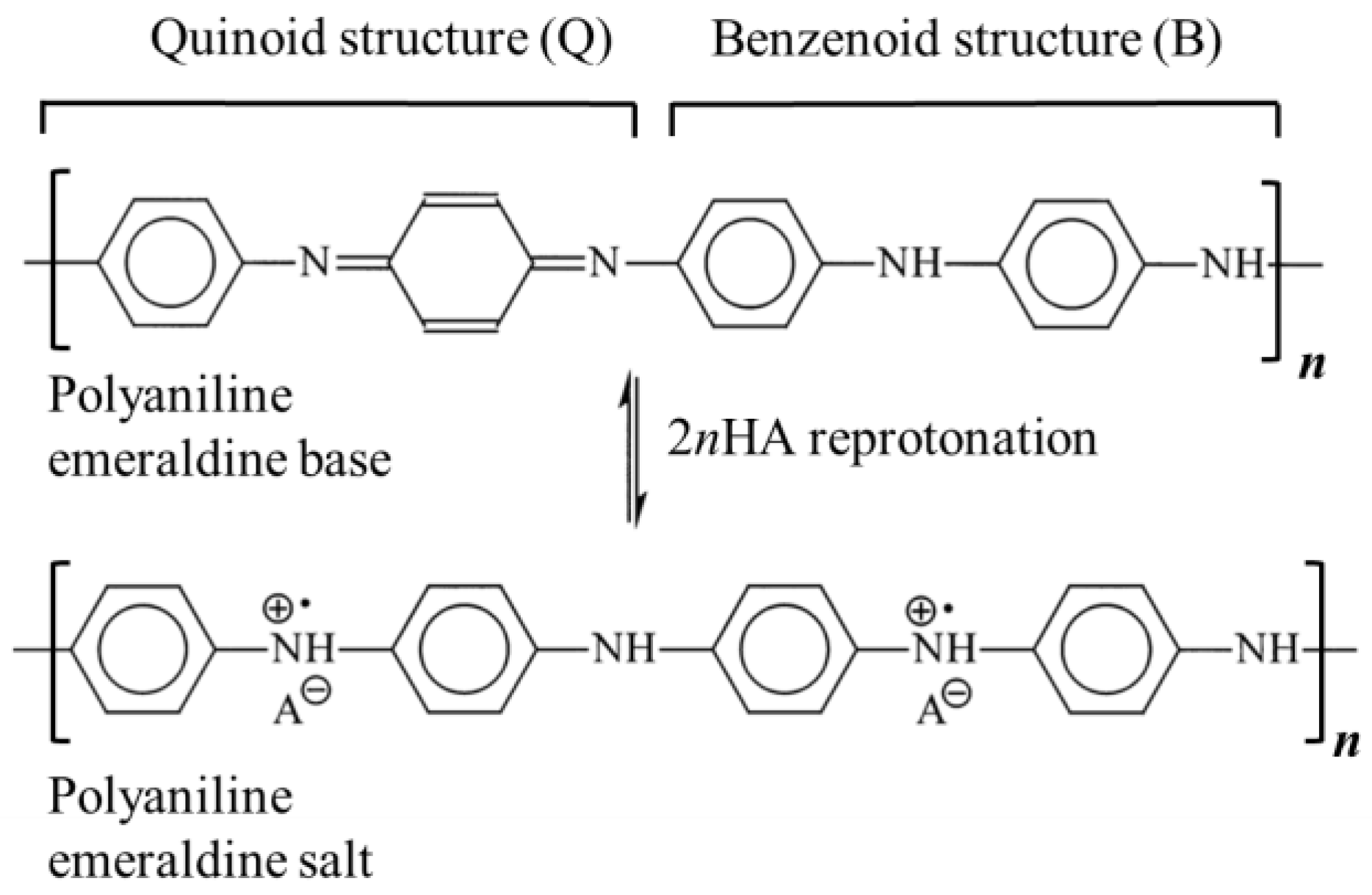
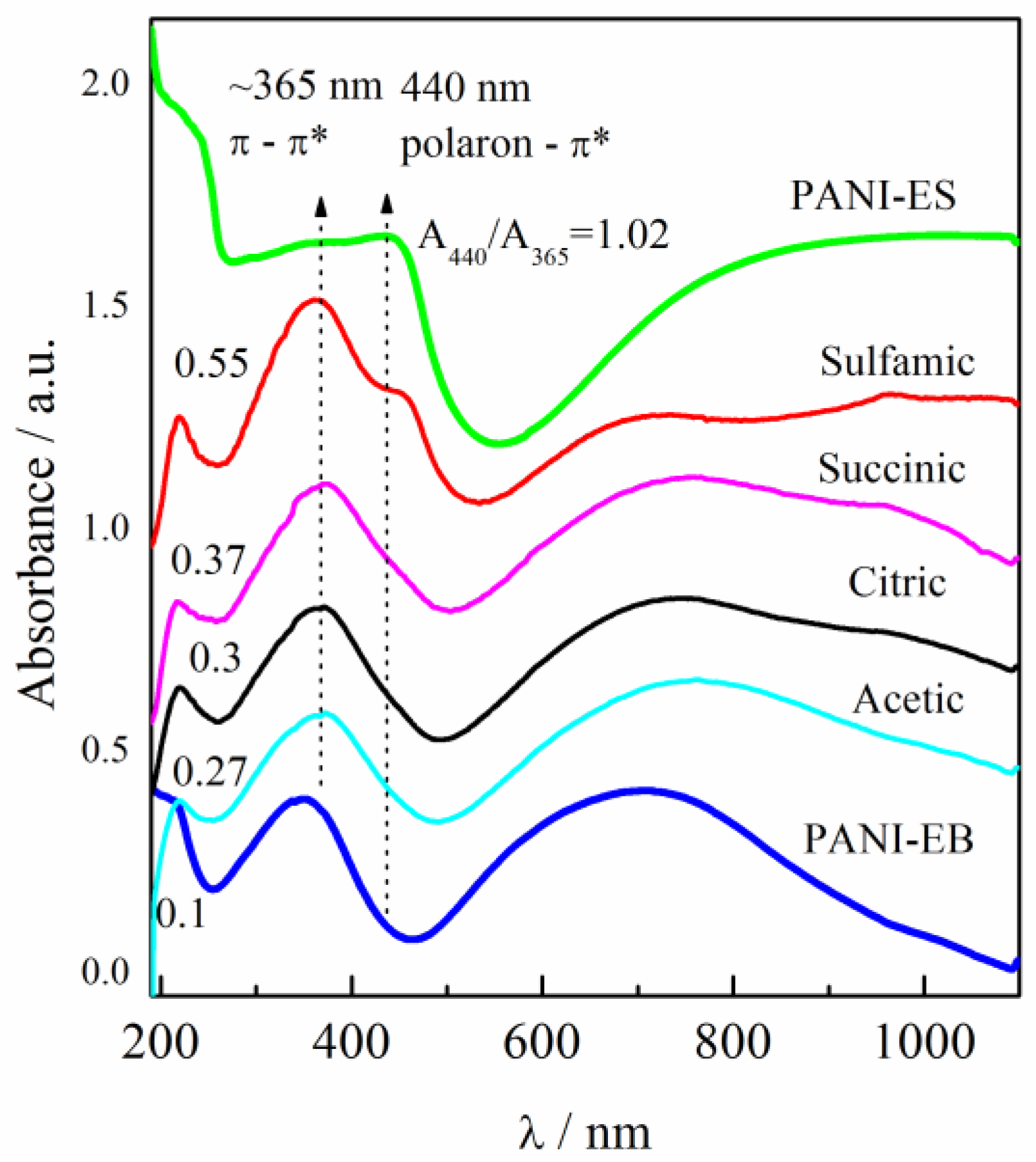
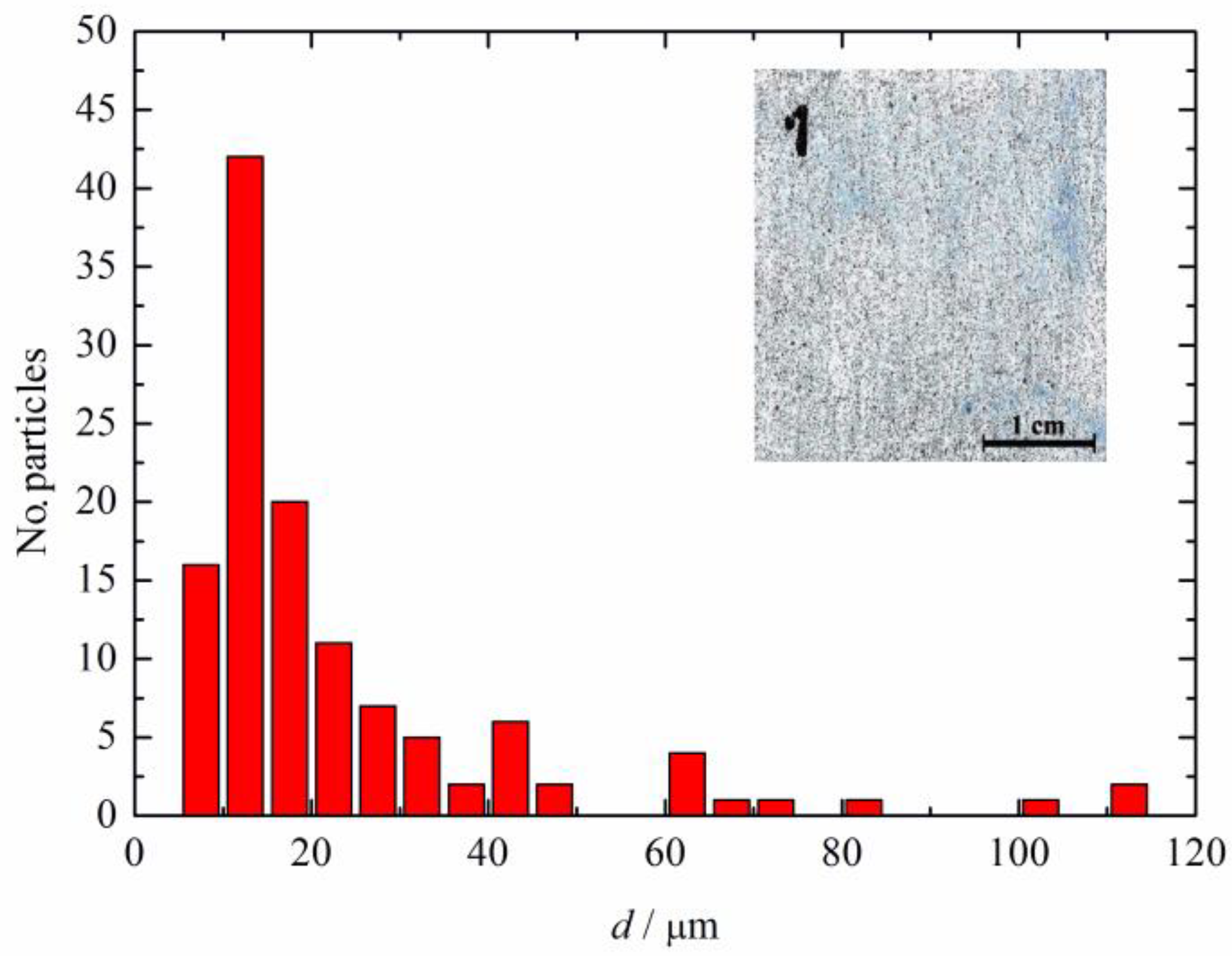

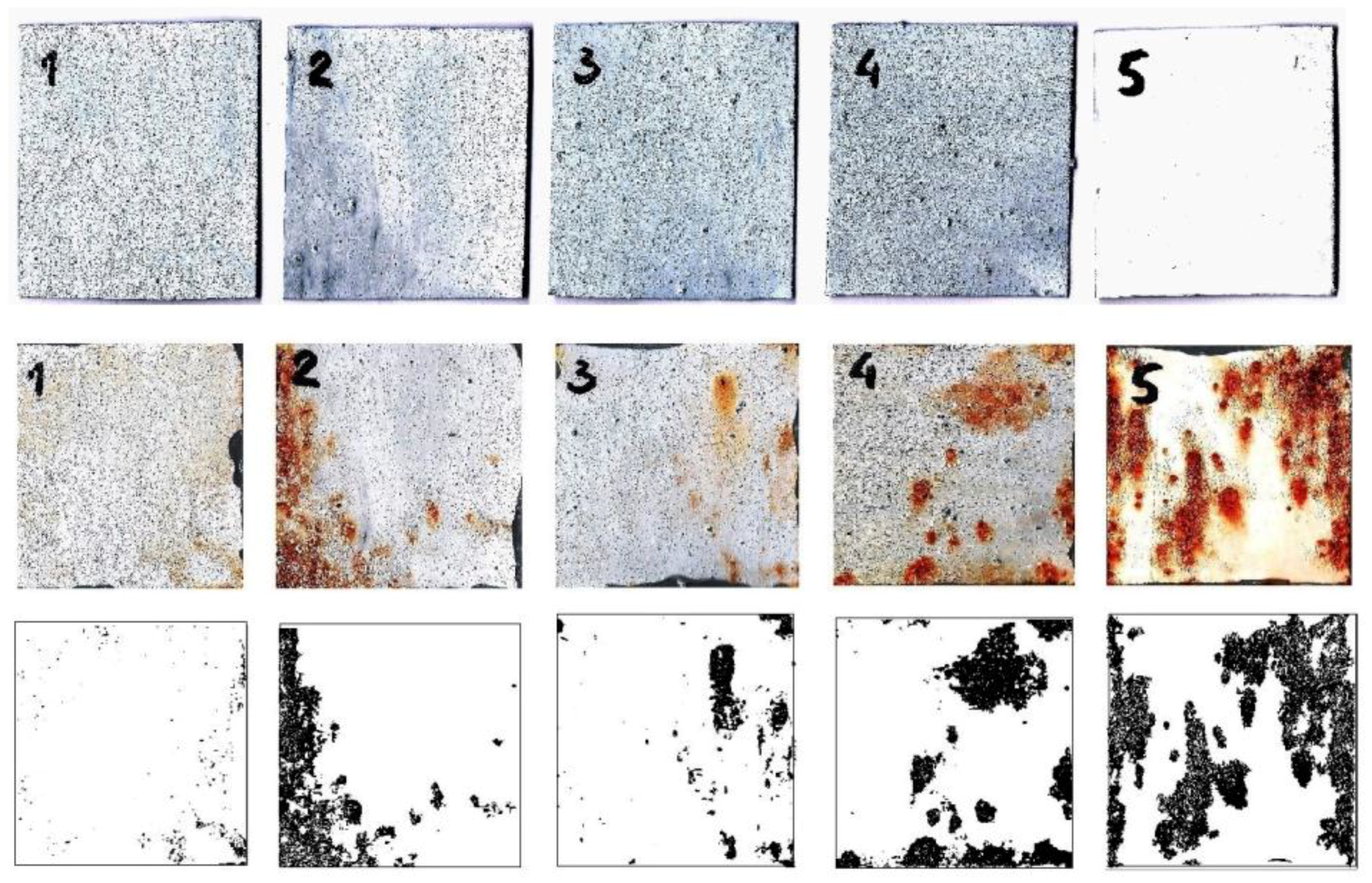
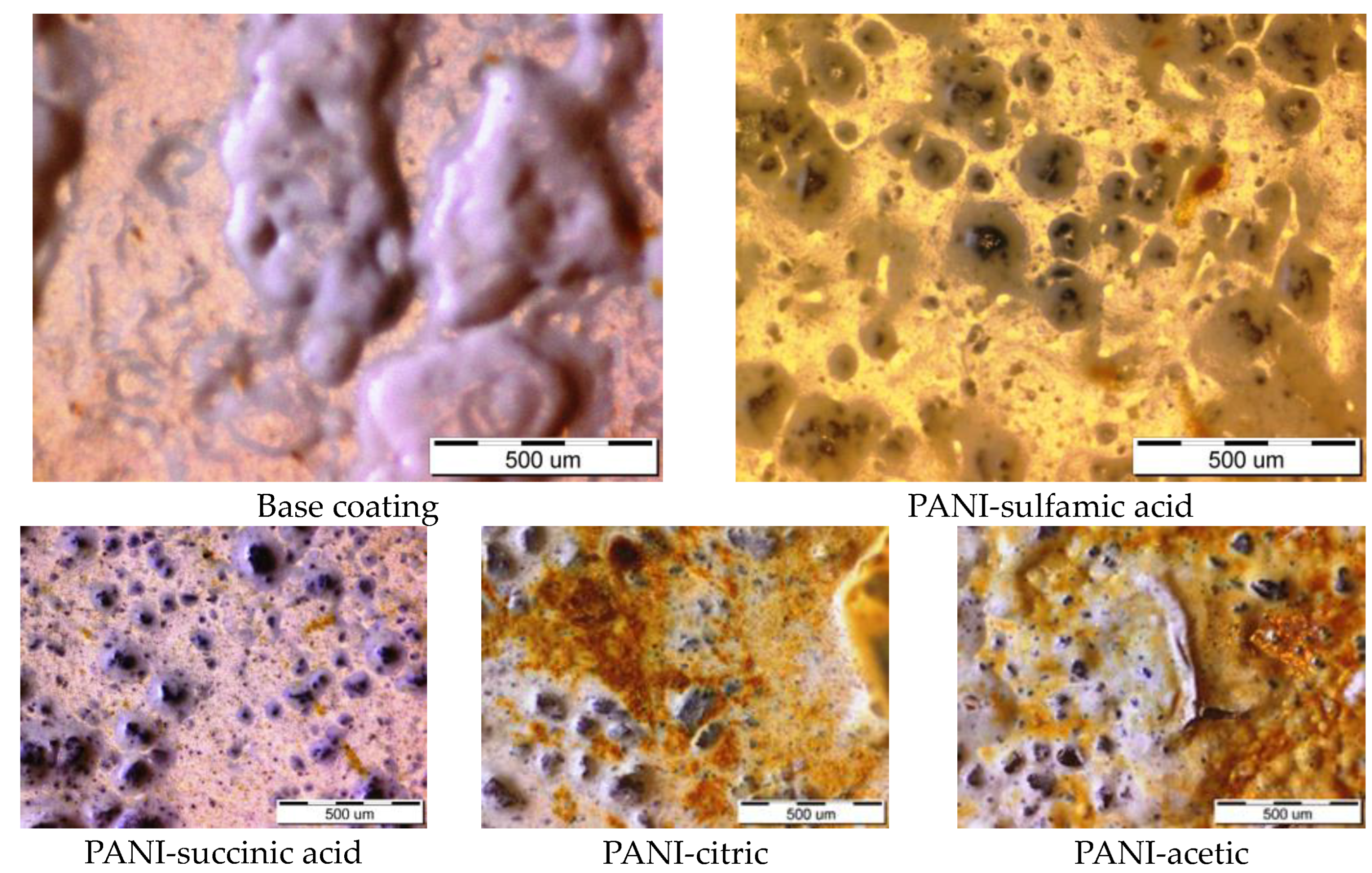
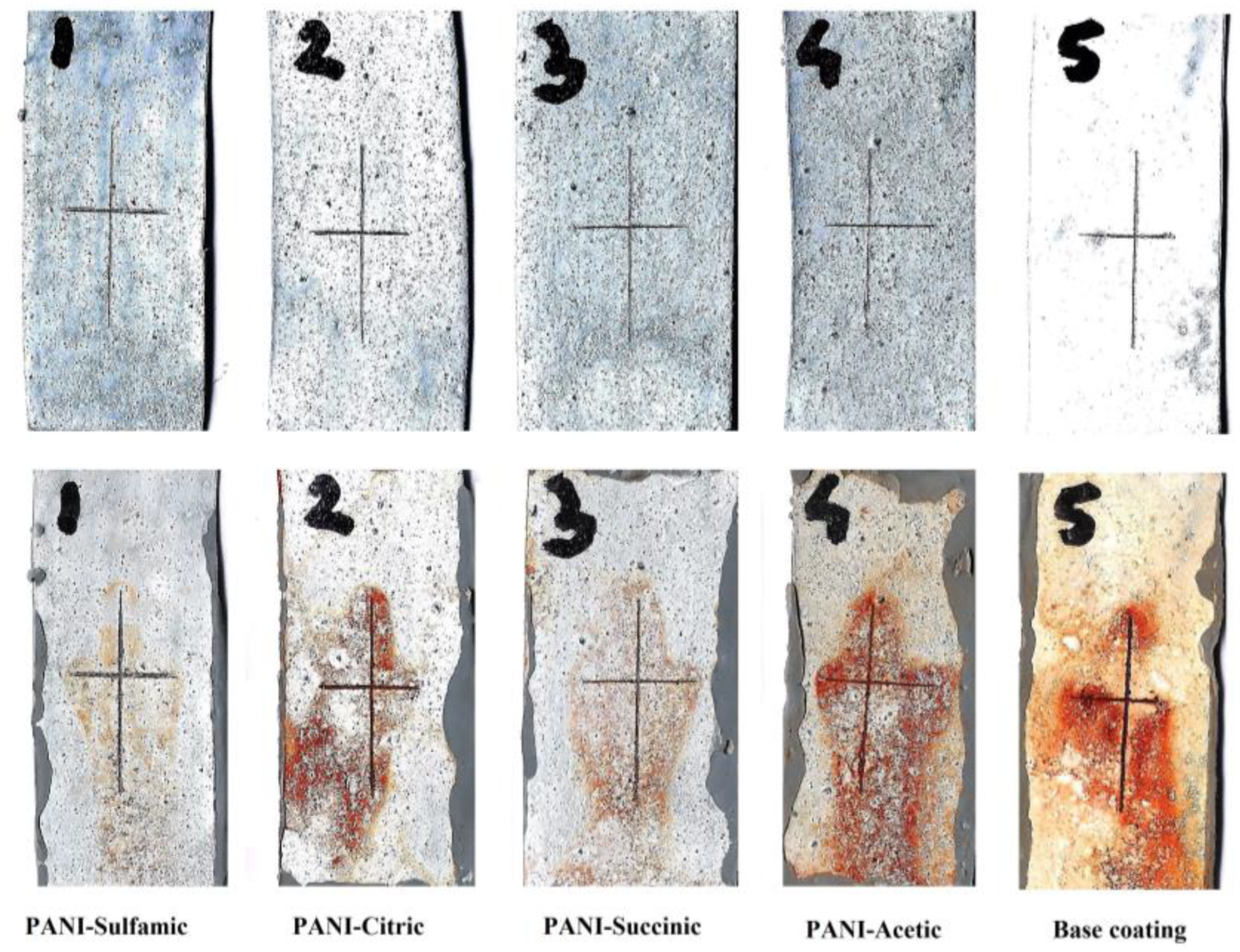
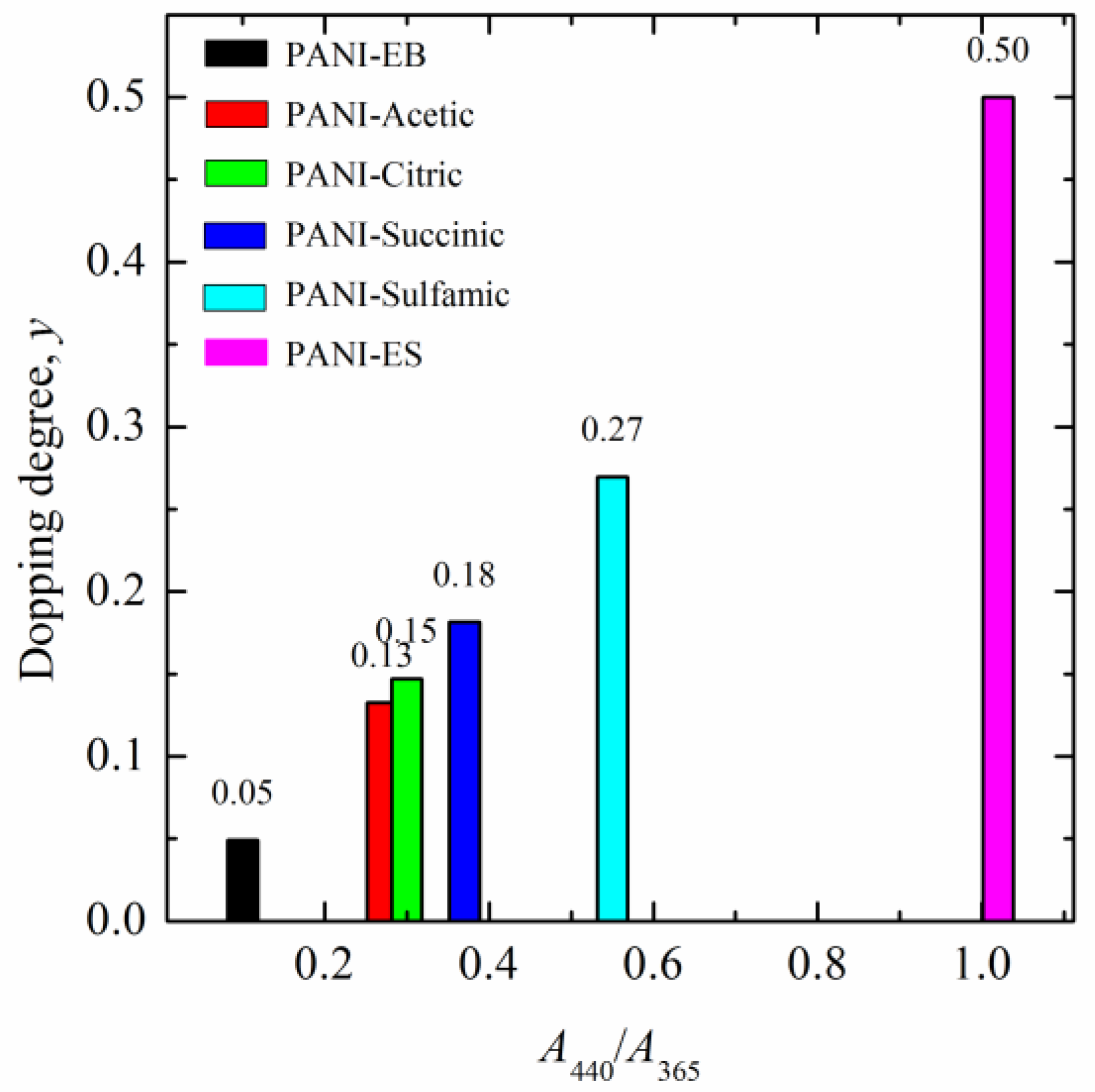
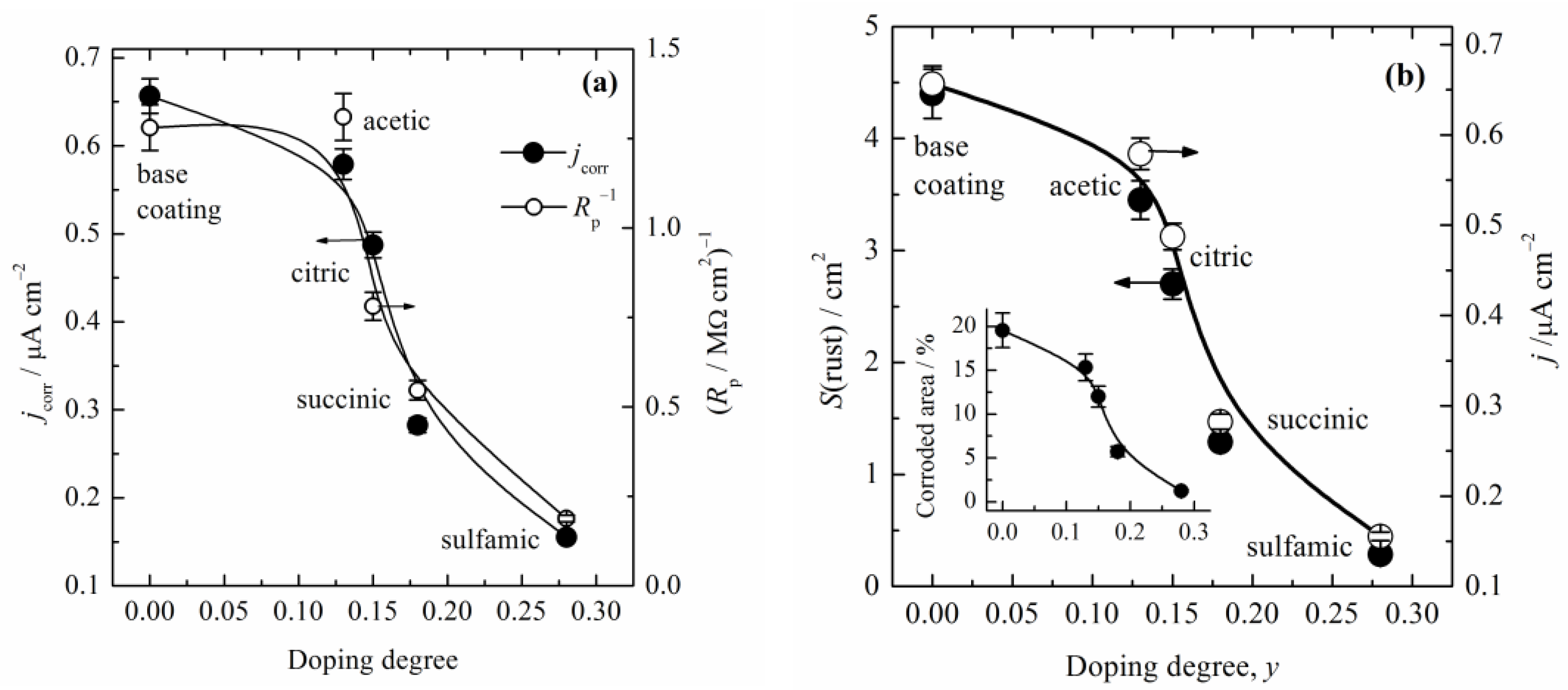
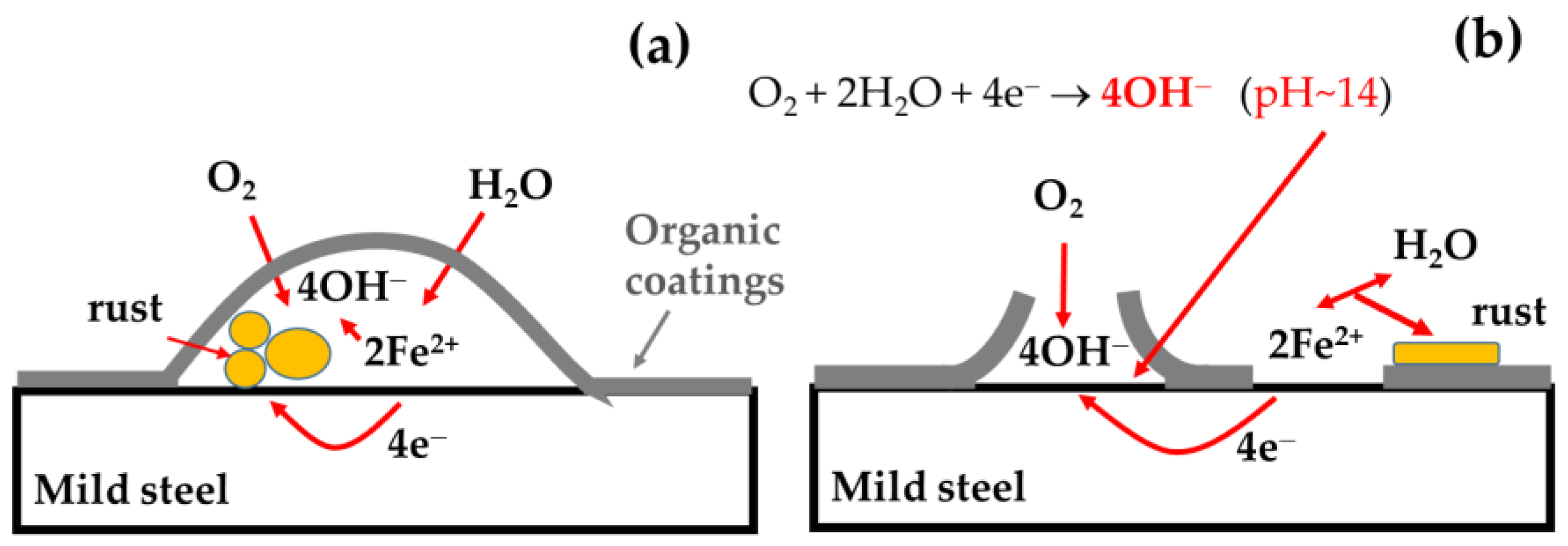
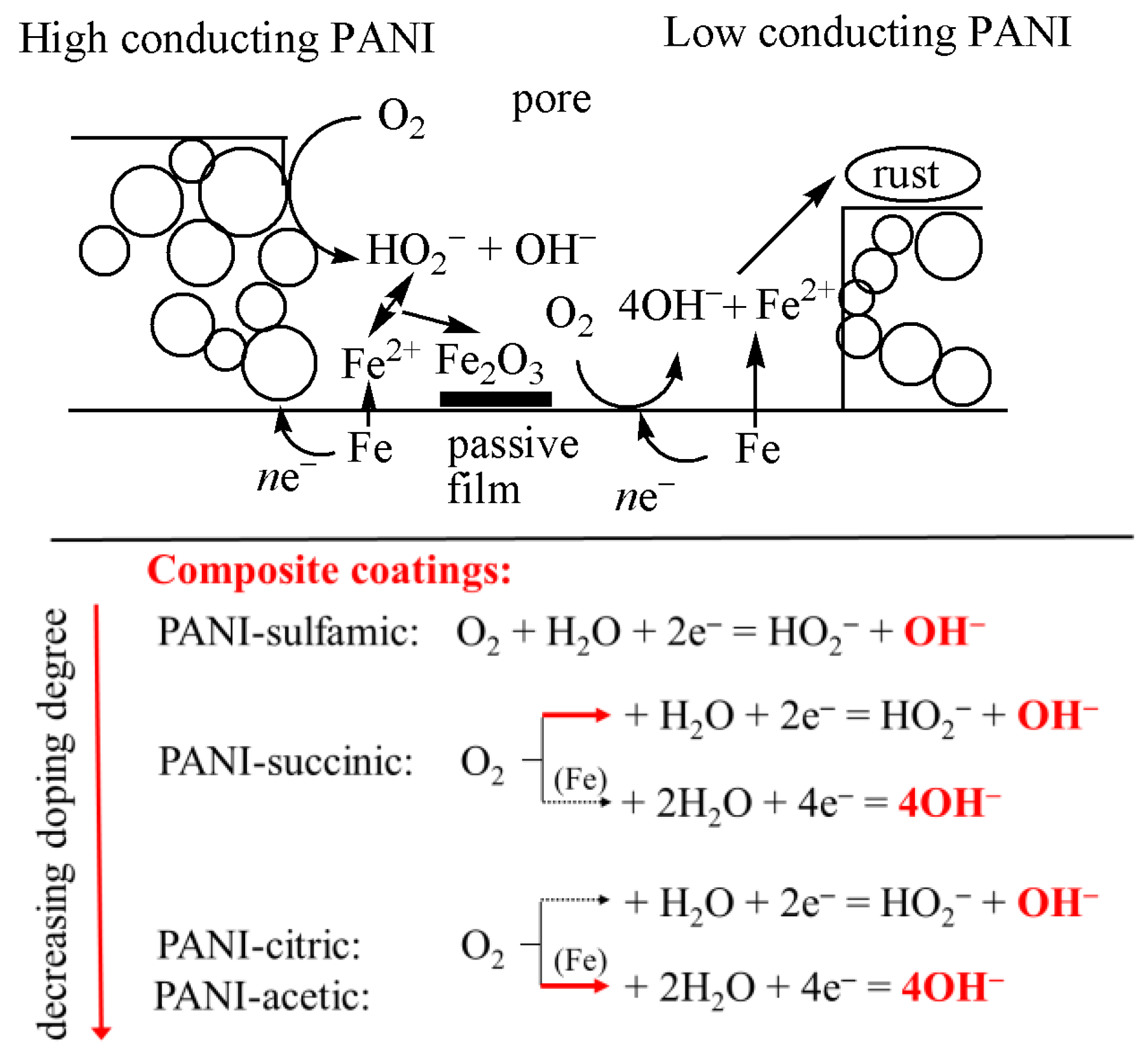
| Acid | Structure | Mw g mol−1 | pKa | cHA M | pH | σ S cm−1 |
|---|---|---|---|---|---|---|
| Acetic |  | 60.1 | 4.76 | 1 | 2.6 | 7.1 × 10−9 |
| Succinic |  | 118.1 | pKa1 = 4.2 pKa2 = 5.6 | 0.87 (sat) | 2.5 | 5.9 × 10−6 |
| Citric |  | 192.1 | pKa1 = 3.13 pKa2 = 4.76 | 1 | 1.51 | 4.4 × 10−3 |
| Sulfamic |  | 97.1 | 1.0 | 1 | 0.6 | 0.11 |
Disclaimer/Publisher’s Note: The statements, opinions and data contained in all publications are solely those of the individual author(s) and contributor(s) and not of MDPI and/or the editor(s). MDPI and/or the editor(s) disclaim responsibility for any injury to people or property resulting from any ideas, methods, instructions or products referred to in the content. |
© 2023 by the authors. Licensee MDPI, Basel, Switzerland. This article is an open access article distributed under the terms and conditions of the Creative Commons Attribution (CC BY) license (https://creativecommons.org/licenses/by/4.0/).
Share and Cite
Grgur, B.N.; Popović, A.S.; Salem, A. Influence of Alkyd Composite Coatings with Polyaniline Doped with Different Organic Acids on the Corrosion of Mild Steel. Metals 2023, 13, 1364. https://doi.org/10.3390/met13081364
Grgur BN, Popović AS, Salem A. Influence of Alkyd Composite Coatings with Polyaniline Doped with Different Organic Acids on the Corrosion of Mild Steel. Metals. 2023; 13(8):1364. https://doi.org/10.3390/met13081364
Chicago/Turabian StyleGrgur, Branimir N., Aleksandra S. Popović, and Ayad Salem. 2023. "Influence of Alkyd Composite Coatings with Polyaniline Doped with Different Organic Acids on the Corrosion of Mild Steel" Metals 13, no. 8: 1364. https://doi.org/10.3390/met13081364
APA StyleGrgur, B. N., Popović, A. S., & Salem, A. (2023). Influence of Alkyd Composite Coatings with Polyaniline Doped with Different Organic Acids on the Corrosion of Mild Steel. Metals, 13(8), 1364. https://doi.org/10.3390/met13081364








